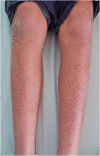Scurvy and food selectivity in childhood: a case report
- PMID: 37729311
- PMCID: PMC10501761
- DOI: 10.31744/einstein_journal/2023RC0356
Scurvy and food selectivity in childhood: a case report
Abstract
Despite its rarity, symptomatic micronutrient deficiency remains a public health problem. Scurvy is the differential diagnosis for bleeding disorders and hematological and rheumatological diseases, especially in patients with eating disorders. However, it is unrelated to autism spectrum disorders or other neurodevelopmental disorders. A previously healthy 10-year-old boy living in São Paulo, Brazil, had a history of significant food selectivity unrelated to autism spectrum disorder, resulting in symptomatic ascorbic acid deficiency (scurvy). This resulted in pain and purpuric lesions on the lower limbs, gingival edema, bleeding during tooth brushing, asthenia, weakness, malaise, and sadness. Therefore, dietary anamnesis is important for routine monitoring of child growth and development. This process helps prevent nutritional deficiencies, facilitates early diagnosis of eating disorders, and enables multidisciplinary follow-up for these patients.
Figures
References
-
- Bailey RL, West KP, Jr, Black RE. The epidemiology of global micronutrient deficiencies. Ann Nutr Metab. 2015;66(Suppl 2):22–33. - PubMed
-
- Ceglie G, Macchiarulo G, Marchili MR, Marchesi A, Rotondi Aufiero L, Di Camillo C, et al. Scurvy: still a threat in the well-fed first world? Arch Dis Child. 2019;104(4):381–383. Review. - PubMed
-
- Swed-Tobia R, Haj A, Militianu D, Eshach O, Ravid S, Weiss R, et al. Highly selective eating in autism spectrum disorder leading to scurvy: a series of three patients. Pediatr Neurol. 2019;94:61–63. - PubMed
-
- American Psychiatric Association . Diagnostic and Statistical Manual of Mental Disorders. 5th ed. Washington, D.C: American Psychiatric Publishing; 2013.



